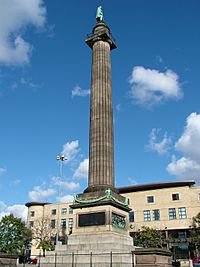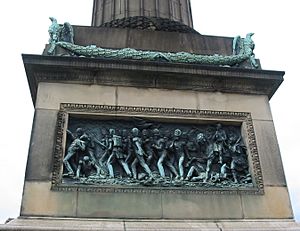Wellington's Column facts for kids
Quick facts for kids Wellington's Column |
|
|---|---|

Wellington's Column
|
|
| Location | Liverpool, Merseyside, England |
| OS grid reference | SJ 351 908 |
| Built | 1861–65 |
| Architect | Andrew Lawson George Anderson Lawson |
|
Listed Building – Grade II
|
|
| Designated | 28 June 1952 |
| Reference no. | 1063784 |
| Lua error in Module:Location_map at line 420: attempt to index field 'wikibase' (a nil value). | |

Wellington's Column, also known as the Waterloo Memorial, is a tall monument in Liverpool, England. It stands proudly on the corner of William Brown Street and Lime Street. This column was built to honor the Duke of Wellington. He was a famous British soldier and leader. This important building is protected as a Grade II* listed building. This means it's a very special historical site.
Contents
Building Wellington's Column
Why the Column Was Built
After the Duke of Wellington passed away in 1852, many cities wanted to remember him. Liverpool decided to build a monument to celebrate his great achievements. A group was formed to collect money from the public. However, it took a long time to gather enough funds.
Choosing the Design and Location
In 1856, a competition was held to find a design for the column. Andrew Lawson, an architect from Edinburgh, won this competition. It took more time to find the perfect spot for the monument. Several places were considered, like Duke Street and Bold Street. Finally, the current location was chosen.
In 1861, another competition took place. This time, it was for the statue of the Duke himself. George Anderson Lawson, who was Andrew Lawson's brother, won this design contest. The column's design looks a lot like the Melville Monument in Edinburgh. That monument was also inspired by the famous Trajan's Column in Rome.
Construction and Completion
The first stone for the column was laid on May 1, 1861. The Mayor of Liverpool was there for this important event. Building the monument had more delays because the ground underneath was sinking a bit.
The column was officially opened on May 16, 1863. The Mayor and Sir William Brown attended the ceremony. However, it wasn't fully finished yet. Bronze pictures showing Wellington's victories and the charge at the Battle of Waterloo still needed to be added. The monument was finally completed towards the end of 1865. This made it one of the last column-monuments built in Britain.
What Wellington's Column Looks Like
Materials and Height
The bottom part of the monument is made from Runcorn sandstone. The main base, called the pedestal, is made of granite. The tall column itself is built from Darley Dale sandstone.
The whole monument stands about 132 feet (40 meters) tall. The column alone is 81 feet (25 meters) high. The statue of the Duke on top is 25 feet (7.6 meters) tall.
Features of the Base
The column stands on a base with steps and a square pedestal. Each side of the pedestal has a bronze plaque. At the corners, you can see bronze eagles connected by decorative swags.
The Column and Statue
On top of the pedestal is a tall, Roman Doric column. It has vertical grooves, called flutes. Inside the column, there are 169 steps. These steps lead up to a viewing platform.
At the very top of the column is a round part with a dome. On this dome stands the bronze statue of the Duke. This statue was made from melted-down bronze from cannons captured during the Battle of Waterloo. The Duke holds a scroll in his right hand, and his left hand rests on his sword.
Bronze Plaques and Battle Names
On the south side of the pedestal, there is a bronze picture. It shows the final charge at the Battle of Waterloo. On the east and west sides, the plaques list the names of the Duke's many victorious battles.
The east panel lists battles like Assaye, Talavera, Argaum, Busaco, Rolica, Fuentes de Onoro, Vimeiro, Ciudad Rodrigo, Oporto, and Badajoz.
The west panel lists battles such as Salamanca, Bayonne, Vittoria, Orthez, San Sebastian, Toulouse, Nivelle, Quatre Bras, and Waterloo.
Around the base of the monument, you can also find old measurements of length. These were used by the Board of Trade before the metric system. There's even a brass strip in the pavement that shows a 100-foot (30-meter) measure and a chain of 100 links.


